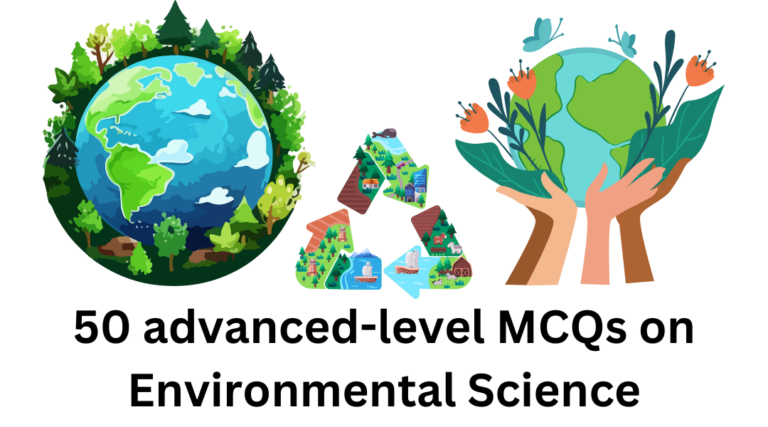Here are 50 advanced-level MCQs on Environmental Science based on a higher difficulty level:
1. Which of the following gases is primarily responsible for the depletion of the ozone layer?
A) Methane
B) Carbon dioxide
C) Chlorofluorocarbons (CFCs)
D) Nitrogen oxides
Answer: C) Chlorofluorocarbons (CFCs)
2. Which of the following is an example of a primary pollutant?
A) Sulfuric acid
B) Nitrogen dioxide
C) Ozone
D) Smog
Answer: B) Nitrogen dioxide
3. The Greenhouse Effect is primarily caused by which of the following gases?
A) Ozone
B) Water vapor
C) Carbon dioxide
D) Nitrogen
Answer: C) Carbon dioxide
4. Which of the following is a non-renewable source of energy?
A) Wind energy
B) Solar energy
C) Geothermal energy
D) Fossil fuels
Answer: D) Fossil fuels
5. The term “Biodiversity Hotspot” refers to regions that:
A) Have a high concentration of endangered species
B) Are located only in tropical rainforests
C) Have high levels of air pollution
D) Are heavily populated by humans
Answer: A) Have a high concentration of endangered species
6. Which of the following ecosystems is the largest carbon sink in the world?
A) Oceans
B) Forests
C) Wetlands
D) Grasslands
Answer: A) Oceans
7. The process of converting waste materials into reusable resources is called:
A) Recycling
B) Composting
C) Upcycling
D) Reusing
Answer: A) Recycling
8. Which of the following pollutants is most commonly associated with acid rain formation?
A) Carbon monoxide
B) Nitrogen oxides
C) Particulate matter
D) Ozone
Answer: B) Nitrogen oxides
9. The term “Ecological Footprint” refers to:
A) The measure of biological productivity
B) The impact of human activities on the environment
C) The area of land covered by vegetation
D) The total area of a protected reserve
Answer: B) The impact of human activities on the environment
10. Which of the following is an example of a biotic factor in an ecosystem?
A) Temperature
B) Water
C) Soil
D) Animals
Answer: D) Animals
11. What is the primary cause of desertification?
A) Deforestation
B) Overgrazing
C) Urbanization
D) Climate change
Answer: B) Overgrazing
12. The depletion of which of the following is linked to global warming?
A) Ozone layer
B) Carbon dioxide levels
C) Methane levels
D) All of the above
Answer: D) All of the above
13. What is the major environmental impact of excessive nitrogen fertilizer use?
A) Eutrophication
B) Desertification
C) Soil erosion
D) Ozone depletion
Answer: A) Eutrophication
14. Which of the following is the main cause of the “Great Pacific Garbage Patch”?
A) Nuclear waste dumping
B) Excessive plastic waste in oceans
C) Heavy industrial activities in coastal regions
D) Agricultural runoff
Answer: B) Excessive plastic waste in oceans
15. Which one of the following gases is considered the most potent greenhouse gas per molecule?
A) Methane
B) Nitrous oxide
C) Carbon dioxide
D) Chlorofluorocarbons (CFCs)
Answer: A) Methane
16. Which international agreement was aimed at reducing global carbon emissions and combating climate change?
A) Kyoto Protocol
B) Paris Agreement
C) Rio Declaration
D) Montreal Protocol
Answer: B) Paris Agreement
17. The “Tragedy of the Commons” refers to the overuse of:
A) Publicly owned resources
B) Private property
C) Agricultural land
D) Forest reserves
Answer: A) Publicly owned resources
18. Which of the following is a characteristic of an invasive species?
A) It is naturally found in the ecosystem
B) It competes with native species for resources
C) It has a beneficial impact on the ecosystem
D) It is always genetically modified
Answer: B) It competes with native species for resources
19. Which of the following is a greenhouse gas that is released primarily from livestock farming?
A) Methane
B) Carbon dioxide
C) Nitrous oxide
D) Ozone
Answer: A) Methane
20. Which of the following is the largest source of anthropogenic (human-caused) carbon emissions?
A) Agriculture
B) Transportation
C) Deforestation
D) Energy production
Answer: D) Energy production
21. Which is an example of biomagnification?
A) Pesticides becoming more concentrated as they move up the food chain
B) Excessive nutrients causing algal blooms in water bodies
C) Pollutants being removed through natural filtration
D) Depletion of a species due to habitat loss
Answer: A) Pesticides becoming more concentrated as they move up the food chain
22. Which of the following is a major contributor to the depletion of biodiversity?
A) Conservation efforts
B) Climate stability
C) Habitat destruction
D) Natural disasters
Answer: C) Habitat destruction
23. Which of the following pollutants is primarily responsible for the formation of ground-level ozone?
A) Carbon dioxide
B) Nitrogen oxides
C) Lead
D) Sulfur dioxide
Answer: B) Nitrogen oxides
24. The “World Environment Day” is celebrated annually on which date?
A) April 22
B) June 5
C) October 16
D) December 10
Answer: B) June 5
25. What is the major environmental risk posed by the burning of fossil fuels?
A) Air pollution
B) Acid rain
C) Soil contamination
D) All of the above
Answer: D) All of the above
26. Which of the following is the main function of wetlands in an ecosystem?
A) Water purification
B) Oxygen production
C) Habitat for birds
D) Soil stabilization
Answer: A) Water purification
27. Which of the following describes the process by which plants use sunlight to synthesize foods?
A) Respiration
B) Transpiration
C) Photosynthesis
D) Decomposition
Answer: C) Photosynthesis
28. Which of the following is the largest source of ocean pollution?
A) Chemical runoff from agriculture
B) Oil spills from ships
C) Plastic waste
D) Radioactive waste from submarines
Answer: C) Plastic waste
29. Which of the following species is considered a keystone species in an ecosystem?
A) A top predator in a food chain
B) A species that provides food for many organisms
C) A species that significantly affects the structure of its ecosystem
D) All of the above
Answer: D) All of the above
30. Which of the following contributes to the acidification of oceans?
A) Increased use of plastic
B) Increased CO2 levels in the atmosphere
C) Increased mercury emissions
D) Excessive nutrient loading from fertilizers
Answer: B) Increased CO2 levels in the atmosphere
31. Which of the following is a result of eutrophication in water bodies?
A) Decrease in fish populations
B) Increased dissolved oxygen
C) Decreased algae growth
D) Increased biodiversity
Answer: A) Decrease in fish populations
32. The environmental issue related to the ‘Ozone Hole’ is caused by which of the following chemicals?
A) Chlorofluorocarbons (CFCs)
B) Nitrous oxide
C) Sulfur dioxide
D) Carbon monoxide
Answer: A) Chlorofluorocarbons (CFCs)
33. Which of the following is an effect of deforestation on the carbon cycle?
A) Increase in atmospheric carbon dioxide
B) Decrease in atmospheric carbon dioxide
C) Increased oxygen levels in the atmosphere
D) Increase in nitrogen fixation
Answer: A) Increase in atmospheric carbon dioxide
34. What is the term used to describe the gradual increase in the Earth’s surface temperature due to human activities?
A) Global warming
B) Acid rain
C) Ozone depletion
D) Desertification
Answer: A) Global warming
35. Which of the following is a common consequence of overfishing?
A) Loss of biodiversity
B) Reduction in fish populations
C) Disruption of marine food webs
D) All of the above
Answer: D) All of the above
36. Which of the following is considered a major cause of ocean acidification?
A) Overfishing
B) Overuse of fertilizers
C) Increased atmospheric carbon dioxide
D) Overproduction of plastic
Answer: C) Increased atmospheric carbon dioxide
37. The term “Sustainability” refers to:
A) The ability to maintain the current standard of living without depleting resources
B) The ability to recycle all forms of waste
C) Reducing pollution levels to zero
D) Increasing industrial development at any cost
Answer: A) The ability to maintain the current standard of living without depleting resources
38. The “Dharavi Model” refers to which of the following in environmental sustainability?
A) Waste recycling
B) Sustainable farming techniques
C) Water conservation techniques
D) Management of urban slums
Answer: A) Waste recycling
39. Which of the following renewable energy sources is considered the most sustainable?
A) Biomass
B) Hydropower
C) Wind energy
D) Solar energy
Answer: D) Solar energy
40. The major environmental concern regarding hydraulic fracturing (fracking) is:
A) Deforestation
B) Groundwater contamination
C) Greenhouse gas emissions
D) Soil erosion
Answer: B) Groundwater contamination
41. Which of the following natural events can significantly affect the global climate?
A) Volcanic eruptions
B) Solar flares
C) El Niño and La Niña events
D) All of the above
Answer: D) All of the above
42. What is the primary goal of the “Kyoto Protocol”?
A) To eliminate poverty
B) To reduce carbon emissions
C) To protect endangered species
D) To stop desertification
Answer: B) To reduce carbon emissions
43. Which of the following is an example of a sustainable agricultural practice?
A) Monoculture farming
B) Crop rotation
C) Excessive pesticide use
D) Soil erosion
Answer: B) Crop rotation
44. Which of the following pollutants is responsible for the formation of photochemical smog?
A) Carbon monoxide
B) Ozone
C) Nitrogen oxides
D) Sulfur dioxide
Answer: C) Nitrogen oxides
45. Which of the following energy sources contributes the least to global warming?
A) Coal
B) Natural gas
C) Oil
D) Wind energy
Answer: D) Wind energy
46. Which of the following is a consequence of excessive irrigation in agriculture?
A) Desertification
B) Waterlogging and salinization
C) Improved soil fertility
D) Increased biodiversity
Answer: B) Waterlogging and salinization
47. Which of the following countries produces the highest amount of carbon emissions globally?
A) United States
B) China
C) India
D) Russia
Answer: B) China
48. Which of the following is an indicator of environmental degradation?
A) Increase in biodiversity
B) Improved soil quality
C) Reduced deforestation rates
D) Increased desertification
Answer: D) Increased desertification
49. The term “carbon sink” refers to:
A) Areas that absorb more carbon dioxide than they release
B) Areas that release more carbon dioxide than they absorb
C) Areas that store radioactive waste
D) Areas that emit no carbon dioxide
Answer: A) Areas that absorb more carbon dioxide than they release
50. Which of the following is a method used to reduce the environmental impact of industrial waste?
A) Incineration
B) Recycling
C) Landfilling
D) All of the above
Answer: B) Recycling
These advanced-level environmental science MCQs cover a range of topics, including pollution, sustainability, climate change, and ecosystem dynamics. Regular practice with such questions can enhance your understanding of key environmental concepts. Stay consistent with your preparation for optimal results!
Comment below if have any doubts on mcqs of environment, 50 advanced-level MCQs on Environmental Science, or any other topiv related to Environmental Science.
Also Read: Computer MCQs for all JKSSB Exams
Also : Highest Peaks in India: MCQs for all Competitive Exams

Sidhant Singh is a highly accomplished professional educator with a diverse academic background. He holds a Master’s degree in History, an MSc in Electrical Engineering and a PhD, demonstrating his extensive knowledge and expertise in both the humanities and the sciences. His unique combination of skills enables him to offer a well-rounded perspective in his teaching and research, making him a valuable resource for students across various fields.
